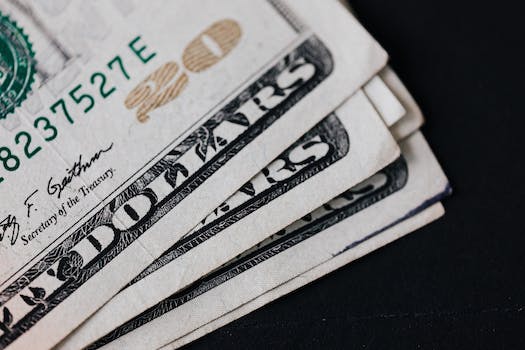How To Save Money Each Month
Introduction

Saving money each month is an important financial goal for many people. By making small changes to your spending habits and budgeting wisely, you can start building up your savings and achieving your financial goals. In this article, we will discuss some practical tips on how to save money each month.
10 Simple Ways to Cut Your Monthly Expenses
Saving money is a goal that many people have, but it can be difficult to know where to start. Fortunately, there are many simple ways to cut your monthly expenses and start saving money each month. Here are 10 tips to help you get started.
1. Create a budget
The first step to saving money is to create a budget. This will help you see where your money is going each month and identify areas where you can cut back. Start by listing all of your monthly expenses, including rent or mortgage payments, utilities, groceries, and entertainment. Then, compare your expenses to your income and see where you can make adjustments.
2. Cut back on eating out
Eating out can be a major expense, especially if you do it frequently. Try to limit your restaurant visits and cook more meals at home. This will not only save you money, but it can also be healthier and more enjoyable.
3. Use coupons and discounts
Coupons and discounts can help you save money on everything from groceries to clothing. Look for coupons online or in your local newspaper, and take advantage of sales and discounts whenever possible.
4. Cancel unnecessary subscriptions
Do you have subscriptions to magazines, streaming services, or other services that you don’t use? Cancel them and save yourself some money each month.
5. Use public transportation
If you live in an area with good public transportation, consider using it instead of driving. This can save you money on gas, parking, and car maintenance.
6. Shop around for insurance
Insurance can be a major expense, but you may be able to save money by shopping around for a better deal. Compare rates from different providers and see if you can get a better deal on your car, home, or health insurance.
7. Cut back on energy usage
Reducing your energy usage can help you save money on your utility bills. Turn off lights and electronics when you’re not using them, and consider using energy-efficient appliances and light bulbs.
8. Buy generic products
Generic products can be just as good as name-brand products, but they’re often much cheaper. Look for generic versions of your favorite products and save money without sacrificing quality.
9. Use cash instead of credit cards
Using cash instead of credit cards can help you avoid overspending and keep your budget in check. Try to use cash for everyday purchases and save your credit cards for emergencies.
10. Negotiate your bills
Finally, don’t be afraid to negotiate your bills. Call your service providers and ask if they can offer you a better deal. You may be surprised at how much money you can save just by asking.
In conclusion, there are many simple ways to cut your monthly expenses and start saving money each month. By creating a budget, cutting back on eating out, using coupons and discounts, canceling unnecessary subscriptions, using public transportation, shopping around for insurance, cutting back on energy usage, buying generic products, using cash instead of credit cards, and negotiating your bills, you can save money and achieve your financial goals. So why not start today?
Creating a Budget: A Step-by-Step Guide
Saving money each month can be a daunting task, but it is essential to achieve financial stability and security. One of the most effective ways to save money is by creating a budget. A budget is a financial plan that helps you track your income and expenses, and it is an excellent tool for managing your finances. In this article, we will provide you with a step-by-step guide on how to create a budget and save money each month.
Step 1: Determine Your Income
The first step in creating a budget is to determine your income. This includes your salary, bonuses, and any other sources of income. It is essential to have an accurate estimate of your income to create a realistic budget. If you have a variable income, you can use an average of your income over the past few months to estimate your monthly income.
Step 2: List Your Expenses
The next step is to list all your expenses. This includes your fixed expenses such as rent, mortgage, utilities, and car payments. It also includes your variable expenses such as groceries, entertainment, and clothing. It is essential to be thorough when listing your expenses to ensure that you do not miss anything.
Step 3: Categorize Your Expenses
Once you have listed all your expenses, the next step is to categorize them. This will help you identify areas where you can cut back on expenses. You can categorize your expenses into essential and non-essential expenses. Essential expenses are those that you cannot do without, such as rent, utilities, and groceries. Non-essential expenses are those that you can cut back on, such as entertainment and dining out.
Step 4: Set Your Budget
After categorizing your expenses, the next step is to set your budget. This involves allocating your income to your expenses. Start by allocating your income to your essential expenses, such as rent, utilities, and groceries. Then allocate the remaining income to your non-essential expenses. It is essential to ensure that your expenses do not exceed your income.
Step 5: Track Your Expenses
Once you have set your budget, the next step is to track your expenses. This involves keeping track of your spending to ensure that you are sticking to your budget. You can use a budgeting app or a spreadsheet to track your expenses. It is essential to review your expenses regularly to identify areas where you can cut back on expenses.
Step 6: Adjust Your Budget
As you track your expenses, you may realize that you need to adjust your budget. This may involve cutting back on non-essential expenses or finding ways to increase your income. It is essential to be flexible and make adjustments to your budget as needed.
In conclusion, creating a budget is an excellent way to save money each month. By following the steps outlined in this article, you can create a realistic budget and track your expenses to ensure that you are sticking to your budget. Remember to be flexible and make adjustments to your budget as needed. With a little effort and discipline, you can achieve your financial goals and save money each month.
The Benefits of Meal Planning and Grocery Shopping on a Budget
Are you tired of feeling like you’re always living paycheck to paycheck? Do you want to start saving money each month but don’t know where to start? One of the easiest ways to save money is by meal planning and grocery shopping on a budget.
Meal planning is the process of deciding what meals you will eat for the week or month ahead of time. This allows you to make a grocery list and only buy the items you need, which can save you money in the long run. When you don’t have a plan, you may end up buying more food than you need or making multiple trips to the grocery store, which can add up quickly.
To start meal planning, take some time to think about what meals you and your family enjoy eating. Look for recipes online or in cookbooks and make a list of the ingredients you will need. Try to choose meals that use similar ingredients so you can buy in bulk and save money. Once you have your list, head to the grocery store and stick to it. Avoid buying items that aren’t on your list, even if they are on sale.
Shopping on a budget doesn’t mean you have to sacrifice quality or taste. Look for sales and coupons on items you regularly use and stock up when they are on sale. Consider buying generic or store-brand items instead of name-brand products. They are often just as good and can save you a significant amount of money.
Another way to save money on groceries is by buying in-season produce. Fruits and vegetables that are in season are often cheaper and taste better than those that are out of season. Plus, they are usually grown locally, which supports your community and reduces your carbon footprint.
When you get home from the grocery store, take some time to prep your meals for the week. Chop vegetables, cook meat, and portion out snacks so you can easily grab them when you’re on the go. This will save you time during the week and help you avoid the temptation to order takeout or eat out.
Meal planning and grocery shopping on a budget can also help you reduce food waste. When you have a plan, you are less likely to buy items that will go bad before you can use them. Plus, you can use leftovers from one meal to make another, which can save you time and money.
In addition to saving money, meal planning and grocery shopping on a budget can also improve your health. When you plan your meals, you can ensure that you are getting a balanced diet with plenty of fruits, vegetables, and whole grains. Plus, you can avoid the temptation to buy unhealthy snacks and processed foods.
In conclusion, meal planning and grocery shopping on a budget are simple ways to save money each month. By taking the time to plan your meals and make a grocery list, you can avoid impulse buys and reduce food waste. Plus, you can improve your health by eating a balanced diet. So, grab a pen and paper and start planning your next grocery trip today!
How to Save Money on Utilities: Tips and Tricks
Saving money is a goal that many people have, but it can be difficult to know where to start. One area where you can make a significant impact on your monthly expenses is by reducing your utility bills. Here are some tips and tricks to help you save money on your utilities each month.
First, consider your energy usage. One of the easiest ways to save money on your utilities is to reduce your energy consumption. This can be done in a variety of ways, such as turning off lights and electronics when they are not in use, using energy-efficient light bulbs, and adjusting your thermostat to a more energy-efficient temperature. You can also reduce your energy usage by using appliances and electronics that are Energy Star certified, which means they are designed to use less energy.
Another way to save money on your utilities is to reduce your water usage. This can be done by fixing any leaks in your plumbing, taking shorter showers, and using a low-flow toilet. You can also reduce your water usage by using a dishwasher instead of washing dishes by hand, as dishwashers use less water and energy than hand washing.
In addition to reducing your energy and water usage, you can also save money on your utilities by shopping around for the best rates. Many utility companies offer different rates and plans, so it is important to compare prices and choose the plan that best fits your needs. You can also consider switching to a different utility provider if they offer better rates or incentives.
Another way to save money on your utilities is to take advantage of energy-saving programs and incentives. Many utility companies offer programs that provide rebates or discounts for energy-efficient upgrades, such as installing a programmable thermostat or upgrading to energy-efficient appliances. You can also take advantage of tax credits and other incentives offered by the government for energy-efficient upgrades.
Finally, it is important to be mindful of your overall energy usage habits. This includes things like turning off lights when you leave a room, unplugging electronics when they are not in use, and using natural light instead of artificial light whenever possible. By being mindful of your energy usage habits, you can reduce your overall energy consumption and save money on your utilities each month.
In conclusion, there are many ways to save money on your utilities each month. By reducing your energy and water usage, shopping around for the best rates, taking advantage of energy-saving programs and incentives, and being mindful of your overall energy usage habits, you can significantly reduce your monthly expenses. So why not start implementing these tips and tricks today and start saving money on your utilities? Your wallet (and the environment) will thank you!
The Importance of Saving for Emergencies and How to Start
Saving money is an essential part of financial planning. It is crucial to have a savings plan in place to prepare for emergencies, unexpected expenses, and future goals. However, saving money can be challenging, especially when you have bills to pay and other financial obligations. In this article, we will discuss the importance of saving for emergencies and how to start.
The Importance of Saving for Emergencies
Emergencies can happen at any time, and they can be costly. Whether it’s a medical emergency, car repair, or home repair, having money set aside for emergencies can help you avoid financial stress and debt. Without an emergency fund, you may have to rely on credit cards or loans to cover unexpected expenses, which can lead to high-interest rates and debt.
Having an emergency fund can also give you peace of mind. Knowing that you have money set aside for emergencies can help you feel more secure and prepared for unexpected events. It can also help you avoid dipping into your savings for other goals, such as a down payment on a house or a vacation.
How to Start Saving for Emergencies
Starting to save for emergencies can be overwhelming, but it doesn’t have to be. Here are some tips to help you get started:
1. Set a savings goal: Determine how much you want to save for emergencies. A good rule of thumb is to have three to six months’ worth of living expenses saved.
2. Create a budget: Review your income and expenses to see where you can cut back and save more. Consider using a budgeting app or spreadsheet to help you track your spending.
3. Automate your savings: Set up automatic transfers from your checking account to your savings account each month. This will help you save consistently without having to think about it.
4. Start small: If you’re new to saving, start with a small amount and gradually increase it over time. Even saving $25 or $50 a month can add up over time.
5. Use windfalls: If you receive a bonus, tax refund, or other unexpected income, consider putting it towards your emergency fund.
6. Avoid dipping into your emergency fund: Try to avoid using your emergency fund for non-emergency expenses. If you do have to use it, make a plan to replenish it as soon as possible.
In conclusion, saving for emergencies is an essential part of financial planning. It can help you avoid financial stress and debt and give you peace of mind. Starting to save for emergencies can be challenging, but with a plan in place, it’s possible. Set a savings goal, create a budget, automate your savings, start small, use windfalls, and avoid dipping into your emergency fund. With these tips, you can start building your emergency fund and be prepared for whatever life throws your way.
Maximizing Your Savings with Coupons and Cashback Apps
Saving money is a goal that many people have, but it can be difficult to achieve. However, there are many ways to save money each month, and one of the most effective ways is by using coupons and cashback apps. These tools can help you maximize your savings and keep more money in your pocket.
Coupons are a great way to save money on everyday purchases. You can find coupons for everything from groceries to clothing to electronics. Many stores offer coupons on their websites or in their weekly ads, and you can also find coupons online through websites like Coupons.com or RetailMeNot. When you find a coupon that you want to use, simply print it out or show it on your phone at the store.
Cashback apps are another great way to save money. These apps allow you to earn cashback on your purchases at participating stores. Some popular cashback apps include Ibotta, Rakuten, and Dosh. To use these apps, simply download them to your phone, link your credit or debit card, and start shopping. When you make a purchase at a participating store, you’ll earn cashback that you can redeem for gift cards or cash.
Using coupons and cashback apps together can help you maximize your savings. For example, if you have a coupon for a certain product and you also earn cashback on that product through a cashback app, you’ll save even more money. It’s important to check the terms and conditions of both the coupon and the cashback offer to make sure they can be used together.
Another way to save money with coupons and cashback apps is to stack them with other discounts. For example, if a store is having a sale on a certain product and you also have a coupon and a cashback offer for that product, you’ll save even more money. It’s important to read the fine print of each offer to make sure they can be stacked together.
It’s also important to be strategic when using coupons and cashback apps. For example, if you have a coupon for a certain product but you don’t need that product right away, it might be better to wait until the product goes on sale before using the coupon. This way, you’ll save even more money. Similarly, if you have a cashback offer for a certain store but you don’t need to make a purchase there right away, it might be better to wait until you do need to make a purchase before using the offer.
In addition to using coupons and cashback apps, there are other ways to save money each month. For example, you can save money by cutting back on unnecessary expenses, like eating out or buying coffee every day. You can also save money by shopping around for the best deals on big-ticket items, like electronics or appliances.
Overall, using coupons and cashback apps is a great way to save money each month. By being strategic and stacking offers, you can maximize your savings and keep more money in your pocket. So the next time you’re shopping, be sure to check for coupons and cashback offers before making your purchase. Your wallet will thank you!
Investing in Your Future: Tips for Saving for Retirement
Saving money each month can be a daunting task, but it is essential for securing your financial future. One of the most important things you can do is to start saving for retirement. Retirement may seem far away, but it is never too early to start planning for it. Here are some tips for saving for retirement and investing in your future.
Firstly, start by setting a budget. This will help you to identify areas where you can cut back on expenses and save more money. Make a list of all your monthly expenses, including rent or mortgage payments, utilities, groceries, and entertainment. Once you have a clear idea of your expenses, you can start to look for ways to reduce them. For example, you could switch to a cheaper phone plan or cancel subscriptions you don’t use.
Next, consider opening a retirement account. There are several types of retirement accounts, including 401(k)s, IRAs, and Roth IRAs. These accounts offer tax advantages and can help you save for retirement. If your employer offers a 401(k) plan, consider contributing to it. Many employers will match your contributions up to a certain amount, which can help you save even more.
Another way to save for retirement is to invest in stocks, bonds, or mutual funds. These investments can provide a higher return than a savings account, but they also come with more risk. It’s important to do your research and consult with a financial advisor before investing.
If you’re self-employed or don’t have access to a retirement plan through your employer, consider opening an IRA. There are two types of IRAs: traditional and Roth. With a traditional IRA, you can deduct your contributions from your taxes, but you will have to pay taxes on your withdrawals in retirement. With a Roth IRA, you don’t get a tax deduction for your contributions, but your withdrawals in retirement are tax-free.
Another way to save for retirement is to pay off debt. High-interest debt, such as credit card debt, can eat away at your savings. By paying off your debt, you can free up more money to save for retirement. Start by paying off your highest interest debt first, and then work your way down.
Finally, consider working with a financial advisor. A financial advisor can help you create a retirement plan and provide guidance on investing. They can also help you stay on track with your savings goals and adjust your plan as needed.
In conclusion, saving for retirement is essential for securing your financial future. Start by setting a budget and looking for ways to reduce your expenses. Consider opening a retirement account, investing in stocks or bonds, paying off debt, and working with a financial advisor. By taking these steps, you can start saving for retirement and investing in your future. Remember, it’s never too early to start planning for retirement.
Conclusion
Conclusion: Saving money each month is a crucial step towards financial stability and achieving long-term financial goals. By creating a budget, reducing unnecessary expenses, and finding ways to increase income, anyone can save money each month. It requires discipline, commitment, and a willingness to make sacrifices, but the rewards of financial security and peace of mind are well worth the effort.






